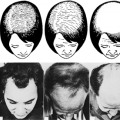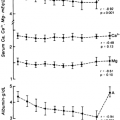ADRENOCORTICOTROPIN: PHYSIOLOGY AND CLINICAL ASPECTS
David J. Torpy
Richard V. Jackson
The existence of an adrenocorticotropic factor was predicted by classic pituitary ablation/pituitary extract replacement experiments.1,2 Ovine and human adrenocorticotropin hormone (ACTH) were later isolated and sequenced.3,4 ACTH, a 39 amino acid peptide secreted by the corticotropes (located centrally in the anterior pituitary gland), stimulates adrenocortical steroid synthesis. Measurement of this peptide, formerly difficult, is now reliable and practical, although ACTH measurements are most useful when autonomous secretion or pathologic suppression of ACTH release is suspected. ACTH release is stimulated by the hypothalamic secretion of corticotropin-releasing hormone (CRH) and arginine vasopressin (AVP)—in response to stress and the circadian rhythm—and inhibited by negative feedback from circulating cortisol. A number of acquired or inherited disorders of ACTH secretion may be manifested by hypercortisolism, adrenal insufficiency, or hyperpigmentation.
Stay updated, free articles. Join our Telegram channel

Full access? Get Clinical Tree





